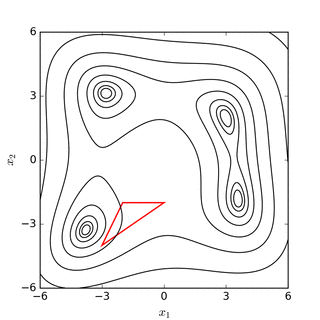Nelder-Mead method
 |
|

Nelder–Mead simplex search over the Rosenbrock banana function (above) and Himmelblau's function (below) |
Nelder–Mead simplex search over the Rosenbrock banana function (above) and Himmelblau's function (below)
The Nelder–Mead method or downhill simplex method or amoeba method is a commonly applied numerical method used to find the minimum or maximum of an objective function in a multidimensional space. It is applied to nonlinear optimization problems for which derivatives may not be known. However, the Nelder–Mead technique is a heuristic search method that can converge to non-stationary points on problems that can be solved by alternative methods.
The Nelder–Mead technique was proposed by John Nelder & Roger Mead (1965).
The method uses the concept of a simplex, which is a special polytope of n + 1 vertices in n dimensions. Examples of simplices include a line segment on a line, a triangle on a plane, a tetrahedron in three-dimensional space and so forth.
The method approximates a local optimum of a problem with n variables when the objective function varies smoothly and is unimodal.
For example, a suspension bridge engineer has to choose how thick each strut, cable, and pier must be. These elements are interdependent, but it is not easy to visualize the impact of changing any specific element. Simulation of such complicated structures is often extremely computationally expensive to run, possibly taking upwards of hours per execution. An engineer may therefore prefer the Nelder–Mead method as it requires fewer evaluations per iteration than other optimization methods.
Nelder–Mead in n dimensions maintains a set of n+1 test points arranged as a simplex. It then extrapolates the behavior of the objective function measured at each test point, in order to find a new test point and to replace one of the old test points with the new one, and so the technique progresses. The simplest approach is to replace the worst point with a point reflected through the centroid of the remaining n points. If this point is better than the best current point, then we can try stretching exponentially out along this line. On the other hand, if this new point isn't much better than the previous value, then we are stepping across a valley, so we shrink the simplex towards a better point. An intuitive explanation of the algorithm is presented in
...
Wikipedia
